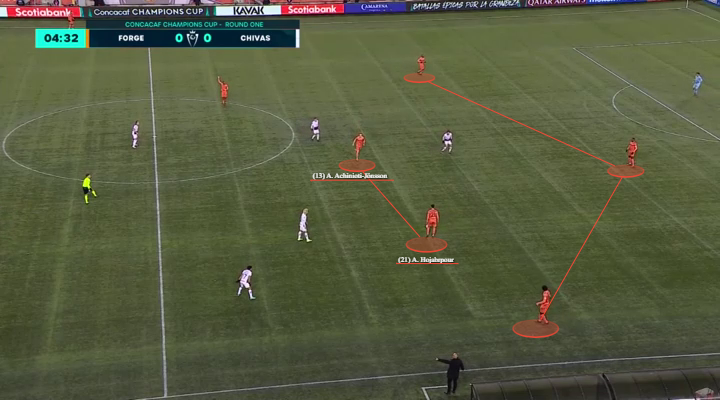In terms of goal-scoring, Thomas Tuchel’s first game in charge of Chelsea might not have gone as planned. But his team still put up a magnificent, tactically intriguing performance, and much promise for the future certainly remains. Given that he had only one day in charge of the Blues before this match, Tuchel certainly managed to get his point across regarding the tactical innovations that he wanted to implement in this match and the players seemed to follow his instructions incredibly well. The German manager changed Lampard’s team more than expected, and even implemented a highly intriguing 3-2-5 attacking shape. Let’s get right into this tactical analysis of Thomas Tuchel’s Chelsea in their 0-0 draw against Wolverhampton Wanderers.
formation: 3-2-5 / 3-4-3

Thomas Tuchel’s side set up in what was likely supposed to resemble a 3-4-3 formation. However, they spent 79% of the game on the ball and most of that time in Wolves’ half, so their attacking shape of 3-2-5 took center stage throughout the match far more than anything else. At times with Azpilicueta joining the midfield line, it looked more like 2-3-5, but let’s not get too overly-complex.
Edouard Mendy retained his place in goal and secured a clean sheet. He had a very minimal impact in build-up phases due to the team’s reliance on central midfielders in the build-up, plus Chelsea’s high position throughout the game. Cesar Azpilicueta played as the right-centre-back, jumping forward into the attack on a far more frequent basis than Antonio Rudiger, who featured as the left-centre-back. Thiago Silva played in between them and had a somewhat important role in the build-up as well, although most of the time ushered it towards Kovacic and Jorginho to take it from there. Given how much time Tuchel’s team spent on the ball in this match and how much the German likely intended on doing, it makes perfect sense why he deployed a double-pivot of Mateo Kovacic on the left and Jorginho on the right. Kovacic was slightly more important to switching play, dropping deep to pick up the ball from Silva, and simultaneously covering in defense in both wide areas. Jorginho adopted a slightly higher position at times, but also had more of a stagnant role of shuffling from left to right. Like Kovacic, he was important to the team’s ability to win the ball back quickly and go immediately on the attack.
Embed from Getty ImagesCallum Hudson-Odoi played an intriguing role as the right-wing-back in the side, staying very wide throughout the match and looking to beat his man and put in crosses at every opportunity. Ben Chilwell played as the left-wing-back and played more inverted passes into central areas, rather than the 1v1 crossing game Hudson-Odoi deployed. Hakim Ziyech, Kai Havertz and Olivier Giroud made up the rest of the attack in central areas. It was more 3-4-3 in this sense than 3-4-2-1 as Giroud didn’t operate too detached from Havertz and Ziyech, both of whom rarely dropped deep to pick up possession as would be expected in a 3-4-2-1.
This shape was evidently set-up to dominate the ball and try to receive in between the lines of Wolves’ back five and midfield two. Unfortunately for the Blues, Wolves’ low block 5-2-3 formation meant that they found it extraordinarily difficult to play through Nuno’s side. As a result, they had to settle for going around them and delivering crosses. Against other sides that adopt a low-block, Tuchel may persist with this kind of formation, stretching his opposition until they can no longer take it.
kovacic-jorginho build-up & shuffling

As expected and analyzed in our article on Thomas Tuchel’s Principles of Play, Chelsea’s central midfielders were the key men in build-up phases. Rudiger’s inclusion in the lineup was a bit of an interesting one, as his main role was just to recycle possession to Kovacic, given how much time the Blues spent on the ball and how little defending he had to contribute. Azpilicueta was slightly more adventurous on the other side, which perhaps pinpoints one reason why Kovacic was able to get on the ball slightly more than Jorginho. Both were productive and absolutely excellent in possession. Kovacic had 164 touches total, to Jorginho’s 147. Whenever they were in possession it was very much one-touch play. This can be evidenced by the fact that Kovacic made 152 passes out of his 164 touches, and Jorginho 139 out of his 147. When in possession, they hardly ever took more than one touch, and most of their other touches were tackles, looking to win the ball back and start over. Despite this dominance and control, Chelsea were never slow in possession and the two midfield men were crucial to setting the tempo of the match and maintaining the Blues’ dynamism in possession.
Their role in the team was mainly to spread the ball wide to Chilwell or Hudson-Odoi, but they were always on the move in shuffling left to right regardless of if they were in possession or out of possession. After spreading the ball to the wide areas (and Chelsea played with as much width as possible), the two wing-backs had differing roles. Hudson-Odoi mainly looked to take his opposite number on 1v1 and was very successful in the first half at beating Rayan Ait-Nouri with every opportunity. His crosses were of high quality in the first half, and his twinkle toes were on full display. Ben Chilwell on the other side saw more of the ball in the second half, but rarely looked to deliver the ball into the box. Instead, he linked up with Kai Havertz who operated as the left-attacking-midfielder and Mateo Kovacic to switch play to the right.
out of possession + pressing
Embed from Getty ImagesWhen Chelsea were out of possession, they looked to press and win the ball back as quickly as possible. This happened very rarely in the match simply because they had 79% of the ball, but the pressing mentality was very evident. Kovacic and Jorginho were always key to this. When they were pressing from the very front, one of the two would link up in a four man diamond with the three central attackers to press the ball. When it was closer to the wide areas, the central midfielders were again crucial to forming a diamond between outside centre-back, wing-back, and either the attacking midfielder or the other central midfielder.

A few times in the first half, Wolves looked to play longer passes over the top of Chelsea’s defense after winning the ball. Azpilicueta (or even Rudiger) at times were caught too high, leaving space available to be exploited. However, Thiago Silva shifted into the wide area to cut off the attack each time magnificently well. In response, the wide centre-back on that side would cover centrally in case Silva slipped up. Luckily he never did, and Silva was easily able to recycle play to Jorginho or Kovacic to start again.
trouble attacking centrally
Embed from Getty ImagesChelsea attacked with much in the way of width against Wolves, which was a positive in creating chances. But it was also partially a factor out of Wolves’ defensive 5-2-3 shape, which restricted Chelsea’s ability to engage their central attackers centrally. Chelsea saw two issues attacking vertically, particularly in the first half. The first of which, was Havertz and Ziyech having no room to receive in between the lines due to there simply being no space to receive in between the lines. They would have to receive in front of Neves and Dendoncker instead, leaving Giroud isolated up against five players, four of whom are very capable in the air.
The other issue occurred when Giroud would drop in deep to pick up possession instead, leaving Ziyech and Havertz as the higher options in between the lines up against three defenders and two central midfielders, who were shuffling well to screen passes into their feet. If Chelsea were able to find Havertz or Ziyech in space, the attacking midfielders then found themselves surrounded by three centre-backs in close proximity to one another, requiring them to shift the ball wide instead. This meant that Chelsea relied mostly on attacks down the wings. Hudson-Odoi rarely ever cut inside, until Tuchel switched him to the left. It will be interesting to see moving forward, should Hudson-Odoi continue to play, if his role down the wing will be as an out-and-out winger never cutting inside, or if he will show more variety in attacking central areas, should space be available for him to do so. Reece James may also return to the side when he becomes fit again, so it will be interesting to see how Tuchel uses his youth moving forward.
concluding thoughts
Although Chelsea couldn’t secure the win, Thomas Tuchel showed signs of some intriguing tactics against Wolves, and the Blues have their mojo back in terms of dynamism and energy. Chelsea were a bit unlucky in certain stages of the match and completely dominated Wolves. Unfortunately they were lacking that bit of magic up front, despite Kovacic and Jorginho showing much in the way of magic in behind the attack-minded front five. All of Tuchel’s key principles of play appear to be in place so far for the Blues and I personally cannot wait to see more of this Chelsea team in the future.
So there it is! A tactical analysis of Chelsea’s 3-2-5 formation in Thomas Tuchel’s first game in charge. Be sure to check out more on Thomas Tuchel including the articles below and share your thoughts in the comments or on Twitter @mastermindsite. Thanks for reading and see you soon!
You might also enjoy…
-> Why Thomas Tuchel is the Perfect Fit for Chelsea – Tactical Analysis
-> Thomas Tuchel’s Principles of Play – Tactical Analysis
-> Frank Lampard – Chelsea – Tactical Analysis (Post-Sacking)
-> Thomas Tuchel – Paris Saint Germain – Tactical Analysis
If you’re interested in playing like Thomas Tuchel’s 3-2-5 on Football Manager 21, also be sure to check out this great video in collaboration with RDF Tactics.












12 thoughts on “Chelsea 0-0 Wolves – Tactical Analysis – Tuchel’s 3-2-5”